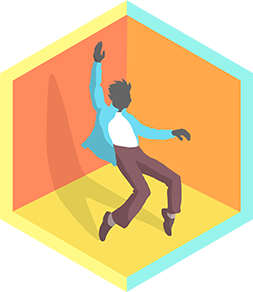Learn A Hip-Hop Routine
Learn and practice a short hip-hop dance routine step-by-step, count beats, master basic moves, and perform the routine confidently for family or friends.



Step-by-step guide to learn a hip-hop routine
Step 1
Put on comfortable clothes and shoes so you can move easily.
Step 2
Clear a safe open space so you have room to dance without bumping into things.
Step 3
Stand in front of a mirror so you can watch your moves and make them sharper.
Step 4
Start your chosen song so you have music to practice with.
Step 5
Tap your foot to the beat and count out loud to eight so you can feel the rhythm.
Step 6
Learn the first move: step-touch by stepping to the right then touching your left foot beside it.
Step 7
Practice the step-touch for eight counts while you keep saying the beat numbers aloud.
Step 8
Learn the second move: a small bounce with a shoulder pop by shifting weight and popping the shoulder on counts two and six.
Step 9
Practice the bounce and shoulder pop for eight counts while staying on the beat.
Step 10
Combine the step-touch and the bounce sequence and practice them together for 16 counts.
Step 11
Add a simple arm pattern like pointing right then left and practice the whole sequence with the arms for three full runs.
Step 12
Perform the full routine confidently for your family or friends so they can see your moves.
Step 13
Share your finished routine on DIY.org so everyone can celebrate your dance!
Final steps
You're almost there! Complete all the steps, bring your creation to life, post it, and conquer the challenge!


Help!?
What can we use if we don't have a full-length mirror, special dance shoes, or access to DIY.org?
Use a handheld mirror or your phone camera propped up as the mirror, wear sneakers or socks on carpet instead of special dance shoes, and share the finished routine with family or upload the video to another site if you can't access DIY.org.
I'm losing the beat when I combine the step-touch and the bounce—what should I do?
Slow the song or use a metronome, keep tapping your foot and counting out loud to eight while practicing the step-touch for eight counts and the bounce/shoulder pop for eight counts until the 16-count combo feels steady in front of the mirror.
How can I adapt this routine for different age groups?
For ages 3–5 simplify to tapping and a slow step-touch, for 6–9 keep the 8-counts and add the small bounce and pointing arms, and for 10+ sharpen the shoulder pops, add more complex arm patterns and do the three full runs before performing.
How can we extend or personalize the dance after learning the basic sequence?
Create your own arm pattern or an extra 8-count after the 16-count combo, add a signature finishing pose for the performance, try different songs to change the vibe, and record a polished video to upload to DIY.org.
Watch videos on how to learn a hip-hop routine
HIP HOP Dance Choreography Tutorial for Beginners - Free Dance Class at Home
Facts about hip-hop dance for kids
💪 A lively hip-hop session boosts cardio and coordination — a 30–45 minute routine can burn a big chunk of energy!
🎵 Dancers usually count steps in groups of eight — learning '1-2-3-4-5-6-7-8' helps nail routines.
🕺 Hip hop dance grew out of 1970s Bronx block parties and street culture — it's over 50 years old!
🌎 Hip-hop is global: the World Hip Hop Dance Championship (started in 2002) draws crews from around the planet.
🔁 Repetition builds muscle memory — repeating a move 20–30 times makes it much easier to perform.
How do I teach my child a short hip-hop routine step-by-step?
What materials do I need to teach a hip-hop routine at home?
What ages is learning a hip-hop routine suitable for?
What are the benefits of learning hip-hop routines for children?


One subscription, many ways to play and learn.
Only $6.99 after trial. No credit card required



